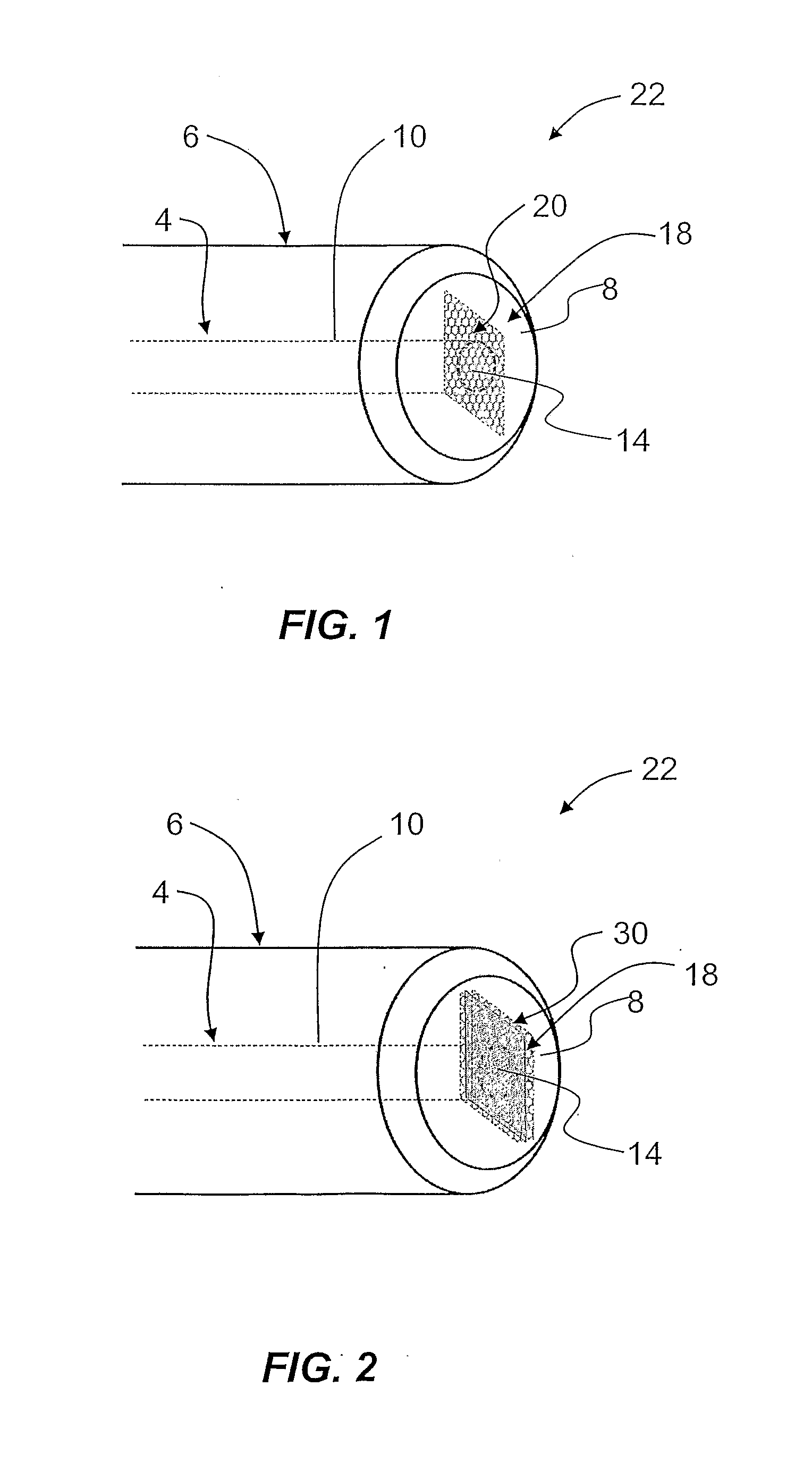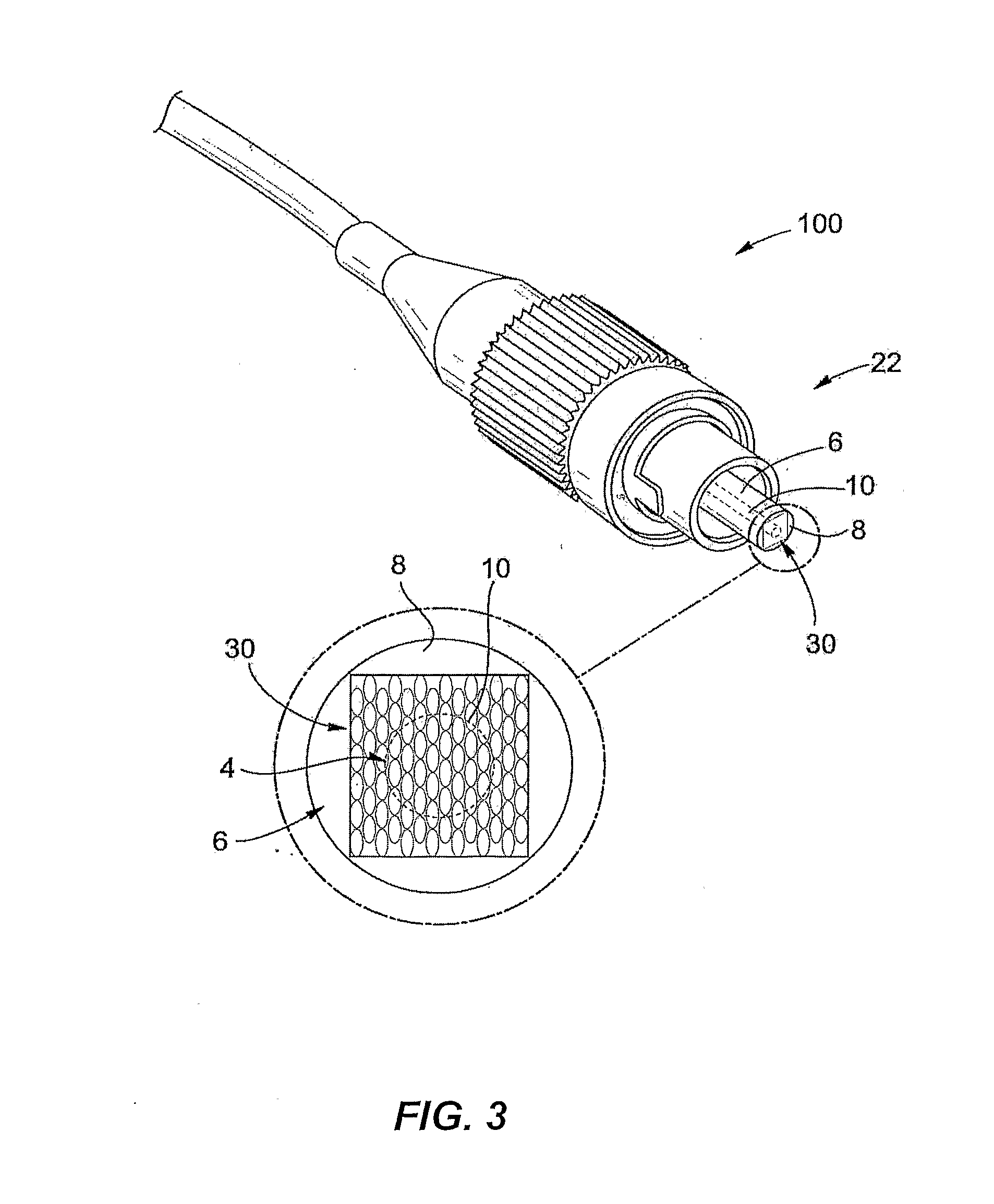Graphene-based saturable absorber devices and methods
a saturable absorber and graphene technology, applied in the direction of paper/cardboard containers, instruments, containers, etc., can solve the problems of complex and costly clean-room-based fabrication systems for sesams, low optical damage thresholds, and increased cavity loss and laser complexity, so as to improve the performance and facilitate the integration with the fabrication process. , the effect of reducing the cost of fabrication
- Summary
- Abstract
- Description
- Claims
- Application Information
AI Technical Summary
Benefits of technology
Problems solved by technology
Method used
Image
Examples
example 1
[0034]FIG. 1 is perspective view of an optical fiber 10 having an end facet 14 that has assembled thereon a graphene-based saturable absorber material 18 in the form of a monolayer graphene film 20 (i.e., one atomic layer of graphene, or “graphene monolayer”) to function as a saturable absorber device 22. The saturable absorber device 22 of FIG. 1 is suitable for use in mode locking and Q-switching fiber lasers, as described below. FIG. 1 shows optical fiber 10 held within an axial pinhole 4 of a ferrule 6 that has an endface 8. Ferrule 6 serves as a fiber holder.
[0035]A graphene monolayer 20 can be obtained using methods such as, for example, mechanically exfoliation, epitaxial growth, chemical vapor deposition and chemical processed (solution processed) methods, as well as laser ablation and filtered cathodic arc methods. After graphene monolayer 20 has been properly prepared on a substrate, the monolayer is removed as a graphene film and is transferred onto the end facet 14 of op...
example 2
[0040]FIG. 2 is similar to FIG. 1 and is perspective view of optical fiber 10 with a graphene-based saturable absorber material 18 in the form of multilayer graphene film 30 (i.e., multiple atomic layers of graphene, or a “graphene multilayer”) assembled on fiber end facet 14 to function as a saturable absorber device 22. The saturable absorber device 22 of FIG. 2 is suitable for use in mode locking and Q-switching fiber lasers, as described below.
[0041]FIG. 3 is a photograph of a fiber pigtail 100 with ferrule 6 that holds optical fiber 10, with multilayer graphene film 30 on endface 8 covering pinhole 4 and fiber end facet 14. Fiber pigtail 100 is inserted into a fiber laser to generate mode locking or Q-switching pulses, as described below.
[0042]FIG. 4 is an enlarged optical image of the end face of fiber pigtail 100 showing a graphene-based saturable absorber material 18 in the form of multilayer graphene 30 on ferrule endface 8 covering pinhole 4 and fiber end facet 14. The as-...
example 3
[0047]FIG. 5 is perspective view of optical fiber 10 similar to FIG. 1 and having a graphene-based saturable absorber material 18 in the form of graphene film 40. Graphene film 40 is formed form monolayer graphene flakes 42 assembled on fiber end facet 14, thereby forming saturable absorber device 22. The saturable absorber device 22 of FIG. 5 is suitable for use in mode locking and Q-switching fiber lasers, as described below.
[0048]In an example, monolayer graphene flakes 42 have a small size, e.g., less than 10 μm. In an example, graphene flakes 42 are assembled onto the end facet of fiber pigtail as a graphene film 40 that covers the pinhole 4, and the pigtail 100 is inserted into a fiber laser to generate mode locking or Q-switching pulses. The small size of graphene flakes 42 are obtained in one example by solution processing routes or by post-treatment of monolayer graphene on a substrate. The post-treatment method includes, but are not limited to, etching chemically (e.g., ac...
PUM
| Property | Measurement | Unit |
|---|---|---|
| Photochromic | aaaaa | aaaaa |
Abstract
Description
Claims
Application Information
 Login to View More
Login to View More - R&D
- Intellectual Property
- Life Sciences
- Materials
- Tech Scout
- Unparalleled Data Quality
- Higher Quality Content
- 60% Fewer Hallucinations
Browse by: Latest US Patents, China's latest patents, Technical Efficacy Thesaurus, Application Domain, Technology Topic, Popular Technical Reports.
© 2025 PatSnap. All rights reserved.Legal|Privacy policy|Modern Slavery Act Transparency Statement|Sitemap|About US| Contact US: help@patsnap.com



